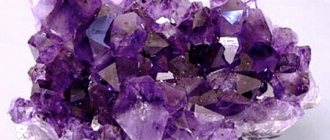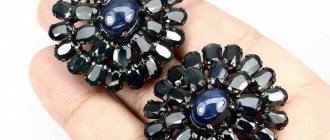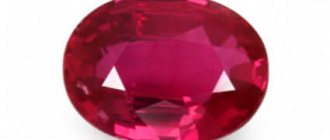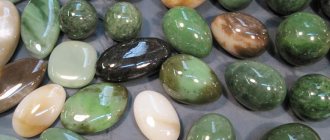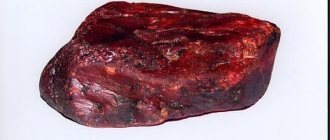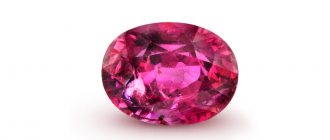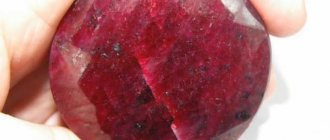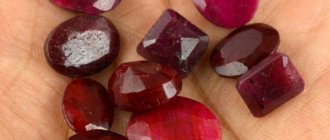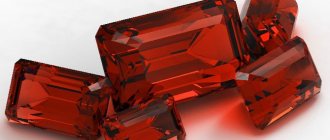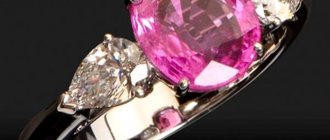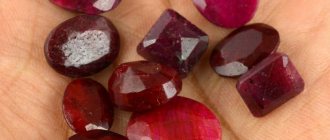As sad as it may be, many stones on the market have been refined. The most common method of refining is heat, which some stones like ruby, sapphire, tanzanite or blue zircon are almost always subjected to. Some stones, such as blue topaz, for example, are irradiated: in fact, it is impossible to find a richly colored topaz that has not been irradiated. One of the most insidious methods of refining is coating. Such stones tend to peel off. Cracked stones like emerald are refined with oils, resins and other substances: cracks in the stone, saturated with them, cease to be noticeable. One of the new ways to refine corundum is diffusion using beryllium impregnation. This is how 99% of colored sapphires are obtained (so-called fancy sapphires). Rubies are boiled in red glass, this leads to filling of cracks and intense coloring. Sometimes it seems that there are no untreated stones left at all.
It is important to understand that ennoblement in itself does not bring anything bad. Treated natural stones remain natural, especially when natural techniques such as heating are used. This is only bad if the seller passes off a refined stone as an untreated one in order to increase the price. Conscientious sellers will always tell the history of the stone (if, of course, this is possible) and will not pass off irradiated blue topaz as topaz with a natural rich color, such as 0.00001% of stones.
The idea of gentrification is far from new. Pliny's Natural History covers a wide range of techniques for altering stones, including heat, oil impregnation, bleaching, and various coatings. Some of these ancient techniques are clearly fraudulent, but now refinement is simply a way to provide the market with material in the face of very limited supplies of new natural stones.
Despite the spread of refinement and refined stones, for those who accept only stones in their original form, without any improvements other than cutting, there are still opportunities to find something interesting. There is no need to tempt fate in finding unrefined sapphires and rubies. There are several varieties of stones that combine good characteristics - hardness, durability, brilliance and transparency - with stunning color, although they have not been refined. You can buy such stones with complete confidence that the color will be natural. Here are a few such stones:
Spinel (more accurate name: noble spinel)
This mineral is distinguished by a crazy abundance of different shades. The stone is so diverse that it is almost impossible to choose a pair for earrings: any two will be at least slightly different. Therefore, by the way, they often collect several stones of different shapes per product. Spinel has a hardness of 8, excellent play of light and transparency. Spinels are often confused with rubies and sapphires, but they also come in other, no less interesting colors: orange, purple, silver, lavender, purple, pink.
Synthetic analogues and imitations
Synthetic ruby for the jewelry industry is produced by several methods based on different physical principles:
- gas-flame method of crystallization of the molten phase (Vernel method);
- methods based on the principle of “pulling” from the melt (Czochralski method, etc.);
- methods based on the principle of zone melting (methods of Bagdasarov, Stockbarger, etc.);
- methods of crystallization from a solution in a melt (group of flux methods)
- methods of crystallization from aqueous solutions (hydrothermal method group).
The following are used as ruby imitations:
- corundum, colored by cavity filling method;
- surface-coated corundum;
- corundum with a layer of artificially grown ruby;
- diffusion-treated corundum;
- doublet: corundum+glass and corundum+garnet;
- natural and synthetic minerals with similar colors;
- colored glass.
Characteristics of real crystals
The characteristics of real rubies are quite rare among other minerals, so an experienced jeweler can accurately identify a fake by the following points:
- crystal hardness. As mentioned above, ruby is second only to diamond in its hardness, which places it in the first class of hardness, and on the Mohs scale it has 9 units. Having such high hardness, the stone is extremely difficult to break, leave a crack or even a scratch;
- cut. Thanks to its hardness, it is easy for jewelers to work with, and it costs an experienced craftsman nothing to make clear, defined edges;
- color As mentioned above, both pink, coral, and red-burgundy rubies are found in nature. It is also common to come across stones with a gradient;
- shine. Compared to igneous origin, only rubies have a strong glossy shine, giving off red highlights when illuminated.
How to distinguish a real ruby from an artificial one
After filling the jewelry market with imitation natural stones, the issue of recognizing a fake has become extremely acute. Today there are many ways to distinguish a real ruby from a fake:
- The easiest way to check the authenticity of a stone is to put it in a glass glass; even a regular faceted one will do. The glow should be reflected from the glass. Synthetic stone does not have such properties.
- If exposed to an ultraviolet lamp, the original will appear red. Synthetics will still glow orange.
- Presence of bubble inclusions. Synthetic stones have one feature. As a result of the ongoing physical and chemical manipulations, tiny inclusions remain on the surface, formed from bubbles of gas released during the reaction.
- Chromium content. Natural stones with a pigeon's blood hue have a very delicate balance of chromium content, which is the root cause of the hue. It is not possible to achieve such a fine balance, and at the same time the shade, in synthetic crystals. Therefore, if a ruby has a “pigeon’s blood” tint, then it is one hundred percent original.
- If it has a crack, then you need to pay attention to its shape. In natural stones it will always be zigzag. This is due to the high hardness of the crystals, which synthetics do not fully possess. She almost always has them straight.
- Weight. A real ruby, since it is a hard and heavy mineral, will always be heavier than it appears visually.
Method 1: Valuing ruby at home
Of course, no one can evaluate a stone better than an experienced jeweler. However, in cases where there is no opportunity to contact a specialist, but you really want to know, there are simple methods for identifying a ruby at home. These manipulations can easily be carried out at home.
The simplest thing you can do is view the stone in natural light. By pointing the crystal towards the sun, the side facing the luminary will play and shimmer, while the opposite side will remain dull.
The second method requires stone and glass. Due to their exceptional hardness, red stones can easily cut glass and thin-walled metal. If a red mark remains in a scratch on glass or metal, this is a sign that, most likely, the stone is not of natural origin.
Naturally occurring crystals are poor thermal conductors. If you take a stone, some recommend placing it on your eyelid and holding it for a short amount of time, it should not heat up quickly. If the stone becomes warm within a couple of minutes, most likely it is synthetic or colored corundum or a completely different stone.
Another effective way is to place the stone in a container of water. A real stone should have a red shimmer in the water.
You should not buy jewelry that does not provide for inspection from the inside. This is an old trick of unscrupulous jewelers, and it is better to refuse such a purchase immediately.
Although this method is dubious, it is worth mentioning. It is believed that if you leave a stone in a glass of homemade cow's milk, the milk will soon turn pink. In this case, the stone is considered to be real. But this method should not be trusted.
Method 2: Consult a jeweler
Why should you turn to specialists? Because even if a stone passes all home tests perfectly, this does not mean that it is worth its price. The stone can simply be reconstructed. Reconstructed natural stones are real fragments fused together.
The master's assessment is a guarantee of authenticity. And if you send the stone for examination to the Assay Office, an organization that guarantees the sale of genuine and high-quality stones in the country, then there is no doubt about the authenticity.
Method 3. Examining the stone with a magnifying glass
For this study, a 10x magnifying glass or microscope is better suited.
What you should pay attention to during inspection:
- edges and cutting. They should be clear and even. If the edges are rounded, the stone is most likely fake;
- shine the stone under a magnifying glass. Examining the glow under a magnifying glass, deep tints and gloss should be easily noticeable. If the stone is star-shaped, then the overflows should have a star shape. It is worth remembering that the non-transparent side should remain cloudy or matte;
- if fragments are examined, then straight, even layers should be visible in the cross-section. In fake stones they are completely chaotic or crooked.
Reasons why they resort to refining stones:
- Price . Natural gemstones without defects are quite rare and their value is very high. Making custom jewelry with ennobled stones makes it possible to get a very beautiful piece of jewelry at an affordable price.
- Aesthetic characteristics . Refining significantly improves the appearance of the stone.
- Demand . If only untreated stones were used in jewelry, they would be practically unavailable. Original work in Moscow using refined stones is exclusive jewelry that is available to a wide range of consumers.
Heat treatment
This method has been known since the times of Ancient Egypt. Craftsmen made jewelry with heated carnelian stones .
High temperature has the following effects:
- Increased transparency.
- Color change.
- Irisation.
- Formation of a pattern of cracks.
- Bleaching
- Getting the asterism effect.
Discoloration of minerals occurs due to the displacement of color centers from their crystal lattice, and a change in color occurs due to the replacement of the original ions by titanium, iron, magnesium or other substances.
What does ennobled Stone mean????
With the help of temperature influences it is possible to obtain:- color change;
— improvement of color (including discoloration);
— partial increase in transparency;
— formation of effects of iridescence or asterism;
- the formation of cracks on the surface of minerals, creating a special pattern - “crackle”.
A color change most often occurs when the original ions in the crystal lattice are replaced by ions of iron, titanium, magnesium, etc., which are color centers. During bleaching, the reverse process occurs - color centers are displaced, and the mineral becomes colorless.
For example, in nature there are amethysts that range in color from deep purple to faint blue, almost colorless. Lightly colored amethysts are practically not used, but with the help of temperature influences it is possible to obtain jewelry inserts with high consumer properties.
When heated from 400 to 500 °C, the stones acquire a rich yellow color, characteristic of citrines. When heated to 500-575 °C, the stone acquires an orange or red-orange color, which is not typical for natural amethysts, which significantly increases the aesthetic properties and, accordingly, the price of the stone. This type of calcined amethyst is called “Madeira Citrine” or “Madeira Topaz”. Some amethysts (for example, from deposits in the USA, Brazil and Zambia) when heated to temperatures of about 400-450 ° C change color not to yellow, but to green, characteristic of praseolite. Another technique is also interesting. If you heat an amethyst on only one side (temperatures of the order of 350-400 °C), then when it cools, the stone will acquire a zonal color: on one side it will retain its natural violet, on the other (heated) it will turn yellow. Such stones are called “amethrines”. If amethyst is heated to a temperature above 600 ° C, you can get a milky-white stone, in appearance strongly reminiscent of base opal. In addition, quite often such stones can exhibit an iridescence effect with a weak bluish glow, then such a stone can serve as an imitation of moonstone.
Heat treatment is used not only for amethysts. Thus, dull pale green beryls, when heated (using temperatures in the range from 400 to 700 ° C), acquire a sky blue aquamarine color.
Chromium-containing brown and red-brown topazes from Brazil, when heated to a temperature of 500 ° C, first become discolored, and then, when slowly cooled, acquire a beautiful pink color (pink topazes are extremely rare in nature). The same effect can be obtained for some topazes from deposits in Russia, the USA and Japan. Unfortunately, the beautiful deep pink color of topaz obtained in this way is unstable and fades when exposed to sunlight.
Brown zircons, after heating to a thousand degrees in air, acquire a golden-brown, less often red, color; if they are heated in a chamber free of oxygen, they turn blue.
Heat treatment is also widely used to enhance existing color, enhancing or weakening the tone or intensity of the color. Thus, sapphires and rubies containing excess iron, which reduces the optical characteristics of gems, after heating (at 700 ° C) acquire a more attractive appearance, becoming more “purely colored” and transparent. Dark-colored (so-called “ink”) sapphires from Australia, when heated to temperatures of about 1500 ° C in an oxygen-saturated environment, partially discolor and become bright blue and transparent. Heat treatment of dark green and dark blue-green tourmalines is also used to bleach and produce a more beautiful emerald color.
Bleaching is widely used for zircons. The fact is that zircon is considered the best natural imitation of a diamond, but colorless transparent zircons are extremely rare in nature (not a single industrially developed deposit is currently known), therefore, to imitate diamonds, colorless transparent zircons are made by heating yellow and brown zircons to temperatures of 850 -950 °C.
In addition, heat treatment can be used to improve the purity index. For example, heating corundum to temperatures of 1600-1900 °C followed by rapid cooling in special media contributes to the disappearance of the characteristic cloud-like inclusions of rutile. However, heating to 1300 °C and subsequent slow cooling at controlled temperatures promotes the recrystallization of rutile into the form of needle-like crystals and the appearance of the asterism effect. When heat treating zircons from Sri Lanka, a cat's eye effect sometimes occurs randomly.
Thermal refining is almost always used for amber. When heated slowly, pores and bubbles are brewed in the amber, which leads to a significant increase in transparency. In addition, a darker honey-brown color is often observed on the surface of amber.
Creating a “crackle” effect on the surface of minerals is mainly used for minerals of the quartz group and is most common for rock crystal. Moreover, this pattern of microcracks can be filled in the future with some kind of dyes or colorless synthetic resins that can create an iridescence effect in the stone.
Thus, with a certain selection of heat treatment conditions (temperature, time and heating rate, the environment in which the process occurs), the consumer characteristics of the mineral can be improved, and in addition, more transparent stones of different types, not typical for other types, can be obtained from gems of the same variety. of this type of jewelry stones of colors, or with uncharacteristic optical effects, and therefore more valuable.
Diffusion treatment
This type of refining can be considered as an independent method or as a type of heat treatment. The essence of the diffusion method is that stones come into contact with special substances containing elements responsible for the formation of color in minerals (for example, iron, titanium, chromium, manganese, etc.). When heated, these elements diffuse into the crystal lattice of the mineral, forming color centers and changing the color of the mineral.
It is believed that the method was discovered in 1949 during experiments with synthetic corundums by Verneuil, in an attempt to create synthetic corundums with the effect of asterism. Widespread commercial use of the method began in the late 70s of the 20th century with the appearance on the market in 1975 of the first diffusion-treated sapphires with a bright blue saturated color.
Diffusion processing of weakly colored corundum is carried out at temperatures of 1750-1900 ° C, while diffusion into the crystal lattice of iron and titanium ions produces a rich blue or blue color, with diffusion of chromium ions (depending on their concentration and the properties of the original mineral) a red color can be obtained, pink or orange color. In 2001, bright orange corundum appeared on the market in large quantities, the color of which was due to beryllium ions. In addition to beryllium, lithium ions were also used to produce “golden” sapphires.
HPHT processing
This refining method was proposed by synthetic diamond manufacturers. Its essence is that when simultaneously exposed to high pressures and high temperatures for several minutes, diamonds are capable of changing color. The first samples, refined by processing using high pressures and high temperatures, first appeared on the market in 1996. These were diamonds, later known under the trade name "Nova". Initially, such diamonds had pronounced yellow and brown shades (which lower the color group, and therefore the cost of the diamond), but after exposure to temperatures of about 2,000-2,200 °C and pressure of 55-60 kBar for 3 minutes, they changed color to green and yellow-green. By slightly changing the processing conditions, you can obtain blue and pink colors.
Since 1999, the American company General Electric Co has been using this method to bleach diamonds of low color groups. Such stones are known on the market under the name “Ge Pol”, since the company marks its diamonds by lasering this inscription onto the girdle.
The high pressure, high temperature method can also be used to produce black diamonds.
Irradiation
The fact that by exposing minerals to wave energy sources it is possible to change their color has been known since the beginning of the 19th century, but this refining method gained commercial significance only in the second half of the 20th century, mainly for the production of fancy-colored diamonds.
The first experiments in creating beautification techniques using various types of radiation were carried out in the USA. When colorless diamonds were irradiated with -particles, a rich green color was obtained (similar to the color of verdelite), which, with the help of further temperature treatment (537 ° C), could be transformed into golden yellow. At the same time, attempts were made to expose diamonds to neutron radiation, thereby obtaining a light green color, which, when the diamond was subsequently heated to temperatures of about 800 °C, became golden brown. Using electrons, light blue and light green diamonds were obtained; -irradiation colors the stones green-blue.
Currently, diamonds are refined using irradiation in nuclear reactors. The starting material is stones of low color groups. By treating yellowish diamonds with radioactive irradiation, more valuable diamonds with a blue tint can be obtained. The reaction of colorless diamonds to radioactive irradiation can be very diverse, which is determined by the technological processing conditions. Thus, electron irradiation makes it possible to obtain green, blue and greenish-blue stones. When exposed to neutrons, diamonds are green in color, which after further high-temperature exposure become pink, purple-red, brown or orange. Neutron irradiation can also be used to produce black diamonds. Radioactivity in diamond crystals occurs when exposed to electrons, neutrons and -particles.
Inconspicuous, almost colorless or colorless specimens of topaz are transformed by radioactive irradiation into deep blue, yellow, tan, orange, pink or green. For topazes, irradiation, as well as irradiation with electrons and neutrons, are used. The first two methods allow you to obtain light blue stones. When exposed to neutrons, a greenish-blue color is obtained, which upon subsequent annealing becomes saturated bright blue. The trade name for such topaz is London Blue. Combined treatment with neutrons and electrons simultaneously also produces a rich blue color, slightly lighter in tone than with neutron treatment. These stones are known on the market under the name “Swiss Blue”. The sale of topazes that have been refined using neutron irradiation is limited in many countries, since such stones become radioactive after processing.
Irradiation is used to refine tourmalines. With this effect, the color of pink and yellow minerals is enhanced, and dark green stones can be given a purple or rich peach color.
The same type of irradiation can be used for quartz. With the help of -irradiation, colorless or lightly colored quartz acquires the rich dark brown color of rauchtopaz. During further heat treatment at temperatures from 140 to 280 °C, quartz acquires a rich greenish-yellow color. These stones are known in the market under the trade name “lemon citrines.” Colorless iron-containing quartz (which, however, is not often found in nature) with the help of this type of irradiation acquires an amethyst color.
Ultraviolet exposure can also be used to refine quartz. Thus, when exposed to ultraviolet radiation, slightly colored dirty gray or dirty greenish layers of agates due to oxidation and dehydration of hydroxide
Effect of temperature on various minerals
Amethysts . Lightly colored stones are found quite often in nature, but are practically not used in jewelry, as they look unpresentable. When exposed to a certain temperature, such minerals become yellow, red or orange. Some stones turn green when heated. Also, for amethysts, heating of the mineral on one side is used, under the influence of which the stones acquire an original zonal color.
Beryls . During the process of refining, pale green stones acquire a sky blue color.
Topazes . Stones of brown tones first become discolored when heated, and after cooling they turn pink. The disadvantage of such stones is that the color fades in the sun.
Zircons . Such minerals can be given blue, red and golden brown colors.
Amber . Slow heating allows you to seal the bubbles and pores inside the stone, and accordingly make it more transparent.
Thermal exposure makes the natural color of the stone brighter, weakens the tone and discolors the stone.
| Amethyst | Beryls | Topaz | Zircons |
| Amber | |||
Valuation of natural rubies
Gemological evaluation of natural ruby is carried out based on an assessment of the main qualitative criteria:
- Weight (expressed in carats), determined by weighing or calculation;
- Color determined in accordance with approved standards for cut ruby or color samples of the International Commission on Illumination (CIE). The color of a ruby for gemological grading purposes ranges from orangeish-red to red with a strong purple tint;
- Purity (in accordance with the approved ruby purity factors) is determined with the naked eye, with the possibility of using an arbitration viewing tool - a triplet magnifying glass with 10x magnification;
- A cut (taking into account the shape factor), characterized comprehensively based on assessments of proportions, symmetry and polishing. As an additional factor in assessing the cut of a ruby, the degree of internal reflection (DIR) parameter is used.
Additional evaluation criteria include:
- Selection is the degree to which the stones in a product match each other. Significant for several or a large number of large stones;
- Optical phenomena - in rubies this is the effect of asterism and “cat's eye”. If they are present, the degree of manifestation and perfection is assessed;
- Patterned textural effects – in rubies this is a “trapiche” pattern. If present, decorative qualities are assessed;
- Availability of reliable information about the stone mining region. Relevant for stones from Burma (Mogok region), Tanzania, USA (Montana).
Properties
Ruby is a type of red corundum. Color varies from pink to burgundy. Depends on the volume of impurities. The most expensive products are those with a lilac tint. Ruby is a stone of the highest category, the composition is similar to the chemical elements of sapphire. The mineral is very durable, only diamond is stronger than it.
The stone is transparent and shiny. He looks very nice. Gemstones other than diamond do not have such characteristic features. Due to its characteristics, a ruby can be more expensive than a diamond of identical size.
Physicochemical characteristics
Ruby contains chromium atoms, which, depending on the amount, impart brightness to the shade.
Physical characteristics:
- hardness. The only thing harder than a ruby is a diamond;
- beautiful shine;
- The density is 4 grams per cubic cm.
Medicinal
Ruby helps to cure many diseases:
- spine pathologies;
- joint problems;
- kidney dysfunction;
- gallbladder disease;
- liver diseases;
- pathologies of the bladder;
- respiratory system disorders.
The mineral helps restore blood circulation. Makes you feel better when your body temperature rises and restores sleep. For treatment, the stone should be placed on the diseased organ. To normalize sleep, it should be placed under the pillow.
Coated stones
Coated stones are a fairly common occurrence among mass-produced jewelry. For example, recently the so-called mystic topazes have become popular with a rather bright multi-colored color, which is actually the result of a special coating (coating). The coatings of some stones are of the “mystic” type, the “titanium” coating is superficial, i.e. is a thin layer of substance on the surface of the faces. Films can be applied to different types of stones. They cannot be recut while maintaining the film effect. Jewelry with such stones must be worn with caution: regular mechanical impact will cause irreversible scratches on the coating.
In the photo: microphotographs of coated pink diamonds in reflected light at 80x and 100x magnification. Source: GIA
Filling cracks and pores in precious stones
Filling cracks and pores is a common method of improving the clarity and attractiveness of many gemstones. For some mineral varieties, impregnation is considered a generally accepted practice. Such stones require special care to preserve the beauty of the stone for a long time. If treated properly, the stone can last you for many years.
The most striking example is emeralds, because 90% of cut stones in the world are impregnated with various substances in order to make cracks less visible; the most common filler is oil. Therefore, it is necessary to avoid heating, due to which the oil becomes less viscous and may begin to leak out of cracks, exposure to chemicals such as liquid detergents, and ultrasonic exposure (ultrasound cleaning).
In the video: emerald trapice
If the cracks are filled with lead glass, for example glass filled rubies, aggressive chemical environments, acids and alkalis, which may react with the filler, should be avoided.
